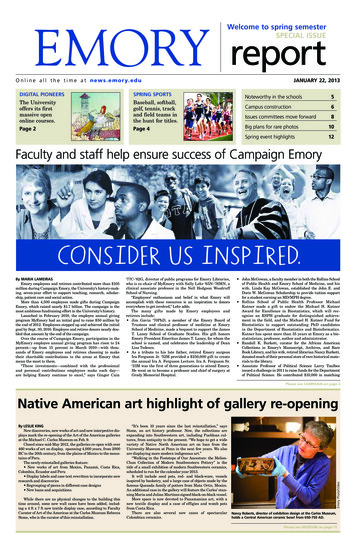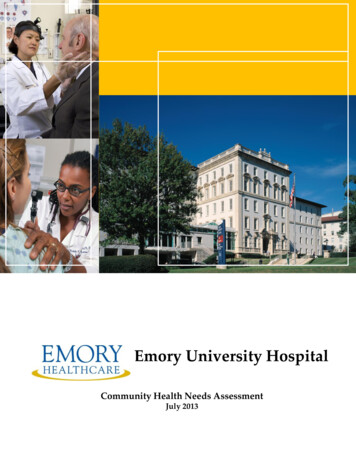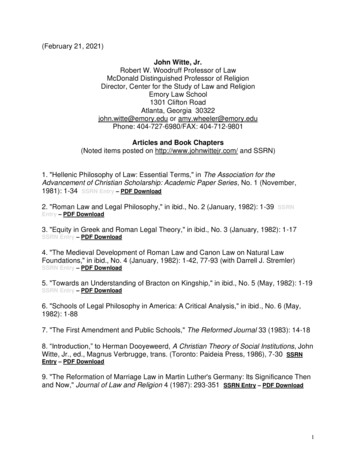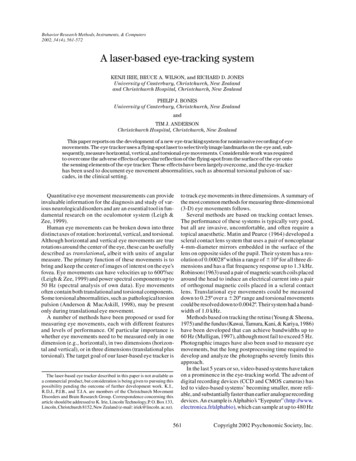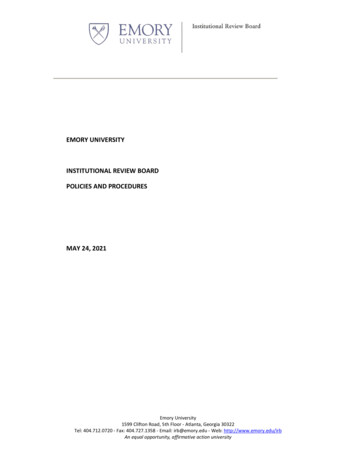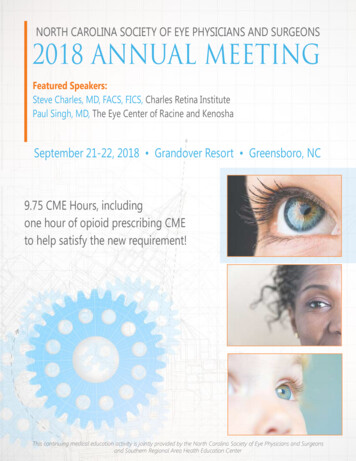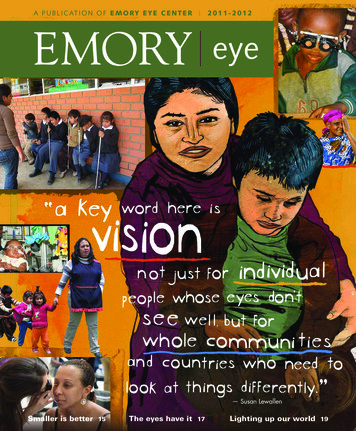
Transcription
OUR HISTORYTHE EMORY EYE CENTER traces its roots backto a time when the practice of ophthalmologywas just beginning in the South—and inthe United States. The year was 1872.Abner W. Calhoun, the region’s first specialist of the eye and ear, came toAtlanta Medical College, established by his father, Andrew B. Calhoun, in1854. The college later became Emory University School of Medicine in1915.As the only scientifically trained ophthalmologist south of Maryland, Dr.Abner Calhoun was the specialist of choice for many a Southerner whohad a serious eye problem before the turn of the 20th century. He servedas faculty president from 1900 until 1910. He and industrialist AndrewCarnegie provided funds to construct a medical college building that laterbecame part of Grady Memorial Hospital, still a training ground for Emoryresidents.From 1910 until 1940, Abner’s son, F. Phinizy Calhoun, Sr., was departmentchairman, earning a reputation as one of the region’s leading ophthalmologists. His successor, Grady Clay, developed an academic program forophthalmology students and for eye, ear, nose and throat resident physicians. Dr. Clay served as department chairman from 1940 until 1946.Phinizy Calhoun, Jr., MDIn 1940, Dr. Clay and Phinizy Sr.’s son, Phinizy Calhoun Jr., organized an ophthalmic pathology laboratory, one of only a handful oflaboratories of its kind in the country. The junior Calhoun went on to serve as department chairman from 1946 until 1978. Duringhis tenure, he helped open an eye bank to serve patients in the Southeast needing cornea transplants. The eye bank was the fifthever established in the U.S.Phinizy Jr. is credited with bringing modern ophthalmology to Georgia. He was the first eye doctor in the state to perform surgery under a microscope and the first in the Southeast to perform a corneal transplant. Colleagues regarded him one of the besttrained ophthalmic pathologists in the country during the 1950s and 1960s, when the subspecialty was beginning to develop.During his many years at Emory, he helped train more than 100 ophthalmologists who now practice across the country.From 1988 to 2007 Thomas M. Aaberg, Sr. continued to expand that reputation as new chair, building the Emory Eye Center (EEC)to what it is today. He is highly regarded as an authority on complicated disorders of the retina. Ophthalmologists around theworld use techniques and instruments Dr. Aaberg developed for surgery on the vitreous and retina. In 2007, Emory announcedthat Timothy W. Olsen, MD (University of Minnesota) would assume the position of new chair, beginning in January 2008. Also aretina specialist, Olsen has both clinical and research interests.
1854 Andrew B. Calhoun, MD, helpsestablish Atlanta Medical College,serving as a professor of general anddescriptive medicine. The collegelater became Emory University Schoolof Medicine.1872 Abner W. Calhoun, MD, AndrewCalhoun’s son, becomes Atlanta MedicalCollege’s first professor of eye and ear.1900 to 1910 Abner Calhounbecomes chairman of the Department ofOphthalmology, Atlanta Medical College.1910 to 1940 Andrew Calhoun’sson, F. Phinizy Calhoun Sr., MD, servesas chairman of the Departmentof Ophthalmology at AtlantaMedical College.1915 Emory University’s board oftrustees charter Emory University Schoolof Medicine, replacing Atlanta MedicalCollege.1940 Grady E. Clay, MD, establishes asmall laboratory for ocular pathology inthe outpatient clinic at Grady Hospital.Financial support was provided by L.F.Montgomery, a prominent Coca-Colaexecutive.1940 to 1946 Dr. Clay succeedsF. Phinizy Calhoun, Sr. as chairman ofthe Department of Ophthalmologyat Emory.1940 Dr. Clay establishes the Emory/Grady ophthalmology residency program at Grady Memorial Hospital.1946 to 1949 Alton Hallum, MD, succeeds Dr. Clay as interim chairman of theDepartment of Ophthalmology.1947 F. Phinizy Calhoun, Jr., MD, performs the South’s first cornea transplantat Emory University Hospital, the flagship hospital of Emory University Schoolof Medicine.1949 Emory opens the Grady ClayMemorial Eye Clinic at Grady MemorialHospital. The clinic serves as a vitalcenter for eye patients in need and forEmory ophthalmologists in training.1949 The Grady Clay Memorial EyeClinic opens an eye bank to servepatients in the Southeast needingcornea transplants. The eye bank isthe fifth ever established in the U.S.The Clinic also establishes a glaucomaservice and a “muscle clinic” for childrenwith strabismus.1950 to 1978 F. Phinizy Calhoun, Jr.,MD, succeeds Dr. Hallum as chairmanof the department. For 115 years, theCalhoun family guided Emory UniversitySchool of Medicine in its development asa preeminent medical institution.Phinizy Calhoun, Jr., MD, was thefourth Calhoun to help develop EmoryUniversity School of Medicine as aleading medical institution. Creditedwith bringing modern ophthalmologyto Georgia, he was the first eye doctorin the state to perform surgery undera microscope.Grady E. Clay, MDColleagues regarded Dr. Calhoun as oneof the best trained ophthalmic pathologists in the country during the 1950s and60s, when the subspecialty was beginning to develop.1953 The Advisory Board for MedicalSpecialties lists 15 board-certified ophthalmologists in Georgia, 12 of whom areEmory doctors and two are Calhouns.1953 The full-time faculty of the Schoolof Medicine establish a private practicefacility, the Emory University Clinic (nowcalled The Emory Clinic). The clinic allowsthe Department of Ophthalmology todevelop a strong clinical research unit.1955 Grady Memorial Hospital dedicates a new facility. The Grady MemorialEye Clinic moves to the new hospital.1961 Emory establishes an orthoptictraining school, the third of its kind inthe country. The one-year graduateprogram trains students in the science oftreating children with strabismus.1964 The Eye Center established theLaboratory for Eye Research, the firstof its kind in the Southeast. Headed byMorton B. Waitzman, PhD, the laboratoryhoused leading scientists conductingPhinizy Calhoun Jr., MDresearch on the causes and treatmentof glaucoma and cataracts. Today theEye Center’s laboratories are located atThe Emory Clinic and Yerkes RegionalPrimate Research Center.1978 to 1986 H. Dwight Cavanagh,MD, PhD, succeeds Dr. Calhoun as chairman of Emory Eye Center (EEC). Underhis leadership and fund-raising efforts,the faculty was expanded significantly,a new building was erected (now ClinicB), and a basic science research programwas initiated.1980 The National Eye Instituteselects EEC to direct the PERK(Prospective Evaluation of RadialKeratotomy) study, the largest and most
Thomas M. Aaberg Sr., MDcomprehensive clinical investigation ofradial keratotomy.1985 EEC is dedicated in a new,five-story building on the university’scampus. In celebration, the Eye Centerinvites 45 guest faculty from across thecountry to speak at a special ophthalmology scientific symposium.1986 to 1988 Louis A. Wilson, MD,becomes interim chairman of theDepartment of Ophthalmology.1988 to 2007 Thomas M. Aaberg,Sr., MD, becomes chairman of theDepartment of Ophthalmology anddirector of EEC. Under his watch, the EyeCenter experiences a growth in staff,physicians and an increase in rankings,taking its place among the very best eyecenters in the country.1989 EEC does its first vision correctionsurgery with an excimer laser.1990 EEC establishes aneuro-ophthalmology program andadds neuro-ophthalmologist NancyNewman, MD, to the faculty.1991 Under the leadership of Ned S.Witkin, OD, the infrastructure of optometry and low vision services is built. Thisgrows into a vital part of the Departmentof Ophthalmology. A new state-of-theart clinic for vision and optical servicesis created on the main campus thirteenyears later.Emory Eye Center, 1365-B Clifton Road NE, Atlanta, Georgia1993 The first master’s degree-levelophthalmic assistant program in thecountry is established at EEC.1994 The Eye Center establishes theEmory Vision Correction Center, thenation’s first refractive surgery center.1995 EEC is one ofa few centers in thecountry with approvalfrom the FDA to sponsora study of laser-assistedin situ keratomileusis(LASIK), a refractivesurgery procedure.1996 EEC receives itsthird five-year Core grantfrom the National EyeInstitute (NEI) of 1.1million.1996 to present U.S. News & WorldReport ranks EEC as a top center in thecountry for ophthalmology.1996 EEC researchers are the first everto publish a totally electronic, peerreviewed life sciences journal, MolecularVision, on the Internet.1998 The Foundation FightingBlindness names EEC a national researchcenter for retinal degenerations with 100,000 in funding for research intovsuch diseases as macular degenerationand retinitis pigmentosa.1999 Emory retina surgeons offera new surgical procedure for the“wet” form of age-related maculardegeneration—retinal translocation.Photodynamic therapy shows promisein halting the progression of “wet” agerelated macular degeneration.2001 A dynamic new generation of vision-enhancingdevices offers independenceto those with low vision,including the JORDY. Thedevice and EEC’s directorof Optometry and VisionRehabilitation, Ned S. Witkin,OD, were seen on “GoodMorning America.”EEC receives a new five-yearNEI Core grant providing 20 consecutiveyears of funding. Henry Edelhauser, PhD,director of research, and his colleagueshave received 1.5 million in researchdollars through the NEI.2002 Emory’s retinal specialists, participants of the NEI’s AREDS (Age-relatedEye Disease Study) at 11 sites nationwide,found that a regimen of dietary supplements could help slow the progressionof macular degeneration (“wet” type) inthose at high risk for the disease.The OHTS trial (Ocular HypertensionTreatment Study) announced findingsthat eye drops used to treat elevated
orbital pressure can be effective indelaying the onset of glaucoma.2003 Cornea specialist Doyle Stulting,MD performs the first U.S. artificial corneal transplant using a promising newdevice—offering hope to those withfailed donor corneal transplants.2004 EEC opens a new in-house LASIKcenter—Emory Vision—at The EmoryClinic Perimeter and completes newspaces for Vision & Optical Services andComprehensive and Contact Lens on themain campus.2005 EEC is the lead center for the NIH’sInfant Aphakia Treatment Study (IATS),to evaluate whether a contact lens orintraocular lens provides optimal visionfor babies born with cataract. ScottLambert, MD is lead investigator.Dr. Jiong Yan began a clinical studyevaluating the Optobionics retinal chipin those with retinitis pigmentosa.2006 Henry F. Edelhauser, PhD (as PI)received a five-year R24 award from NEIto study transscleral drug delivery. Thegrant will bring in 1,172,000 in annualdirect costs: one of the largest researchgrant awards that NEI has awarded. Thisdelivery system will have great impacton the treatment for retinal degenerations and other disorders.EEC receives a 1M grant from the R.Howard Dobbs, Jr. Foundation to support AMD research.Baker Hubbard, MD conducted twotrials to test the efficacy and safety ofLucentis, an intraocular injection withgreat promise that may stop the activebleeding in macular degeneration.EEC was selected as one of the vanguardcenters for the Age-Related Eye DiseaseStudy II (AREDS II), which evaluatesLutein and omega-3 fatty acids and theirrole in preventing AMD progression.2007 Hans. E. Grossniklaus, MD, MBA(Pathology), was granted a 75,000Senior Scientific Investigator Award byResearch to Prevent Blindness (RPB).Researcher Jeff Boatright is awardeda three-year 309,000 grant from theFoundation Fighting Blindness (FFB)to study synthetic bile acids to treatretinal degeneration.Emory announced that Timothy W.Olsen, MD, of the Univ. of Minnesota, wastapped as new director of EEC in January2008. He holds the F. Phinizy Calhoun Sr.Chair. He combines interests in researchwith an active clinical/surgical practice inretinal diseases disorders.Ten persons with retinitis pigmentosa(RP) participated in a “compassionatetrial” and received an innovative implantthat has shown promising results in halting the progression of RP in the NEI trial.2008 CATT, a groundbreaking NEIfunded study, placed two drugs head-tohead (Avastin and Lucentis) to comparetheir effectiveness in treating AMD.EEC was the first U.S. site to conductan innovative trial on keratoconus—aCollagen Cross-Linking w/Riboflavin(CXL) treatment.2009 Using the brain’s ability to reorganize itself, Georgia Tech joins Emory in atrial to help patients with AMD see in anew way using computerized treatment.P. Michael Iuvone, PhD, is appointednew Research Director. PhDs HenryEdelhauser, John Nickerson and Iuvone,along with Hans Grossniklaus, MD, MBA,are tapped as Association for Researchin Vision and Ophthalmology (ARVO)inaugural fellows.2010 Jeffrey Boatright, PhD, is electedpresident of ARVO, the premier visionresearch organization in the country.Michael Iuvone, PhD, is awarded theSenior Scientific Investigator Award bythe Research to Prevent Blindness (RPB).Henry F. Edelhauser, PhD, was named theCharles D. Kelman Innovator’s Lecturerby the American Society of Cataract andRefractive Surgeons (ASCRS). BradleyRandleman, MD, was chosen the firstwinner of the ASCRS Foundation’sBinkhorst Young OphthalmologistAward . Chair Timothy W. Olsen, MD,Timothy W. Olsen, MDreceived the 2010 Macula Society YoungInvestigator Award.One-year outcomes of the IATS trial(2005) show no difference in visualacuity in children, whether the child isfitted with a contact lens or given an IOLimmediately following cataract removal.The Eye Center hosts the inaugural Southeastern Ocular Oncology/Pathology (SEOP) seminar, a forumfor dissemination of knowledge inocular oncology.2011 Maria Aaron, MD, receives oneof 10 national teaching awards forresidency program directors throughACGME.Bradley Randleman, MD, is tappededitor-in-chief of the Journal of RefractiveSurgery. He also receives the international Kritzinger Memorial Award.Henry Edelhauser, PhD, and GeorgiaTech professor Mark Prausnitz, PhD,receive a patent on their microneedleapparatus to effectively deliver drugs tothe back of the eye.Paul Courtright, PHD, and SusanLewallen, MD, of the KilimanjaroCentre for Community Ophthalmology,Tanzania, were recruited to co-direct theEye Center’s new Global Vision Initiative.2012 Technology developed byEdelhauser and Prausnitz leads to a
start-up company that will develop themicroneedle for ophthalmic use.ophthalmologists for special contributions to AAO and ophthalmology.Emory Eye Center is the first centerin Georgia to offer a new technology proven to help the vision of somepatients with end-stageage-related maculardegeneration (AMD), theimplantable miniaturetelescope (IMT).Danny Haddad, MD, is appointed asEmory’s Global Vision Initiative director.Former director of the Atlanta-basedInternational TrachomaInitiative (ITT), he bringsconsiderable expertiseand significant collaborative resources in theprevention of blinding eyediseases throughout theworld.2013 EEC remains at topophthalmology institutionin U.S. News & World Reportrankings.To honor the life workof Henry F. Edelhauser,PhD, former director ofresearch for the Eye Center, the HenryF. Edelhauser Translational ResearchLecture was established.Emory Healthcare acquires Paces PlasticSurgery Center and opens the EmoryAesthetics Center. Oculoplastics physicians Ted Wojno, Brent Hayek and H.Joon Kim provide consultations andprocedures at the new location.With the additions of Uveitis specialists Steven Yeh, MD and PurnimaPatel, MD, EEC opens a dedicatedUveitis and Vasculitis clinical section.In addition, EEC adds a Joint PediatricRheumatology-Uveitis Clinic withChildren’s Healthcare pediatric rheumatologist Sheila Angeles-Han.Allen Beck, MD was appointed to theExecutive Committee of the ChildhoodGlaucoma Research Network (CGRN),an international group of clinicians andscientists who specialize in treating children with glaucoma around the world.Hans Grossniklaus, MD, MBA,was inducted into the AcademiaOphthalmologica Internationalis (AOI), aprestigious international ophthalmologyorganization consisting of the world’stop academic ophthalmologists.Director Timothy W. Olsen, MD, is arecipient of the American Academyof Ophthalmology’s (AAO) prestigious Secretariat Award, recognizing2014 The Infant AphakiaTreatment Study (IATS)releases findings that sayfollowing cataract surgeryin infants use of contactlenses over intraocular lenses is preferable. Scott Lambert, MD, and team atEmory were the national lead center inthis important study at 12 sites throughout the country.Director Timothy Olsen receivesthe Foundation Fighting Blindness“Visionary Award” for his commitment asa researcher and clinican.In December, uveitis specialist StevenYeh, MD, treats Ebola survivor Dr. IanCrozier for his post-Ebola ocular issues.Yeh’s findings of the Ebola virus withinCrozier’s eye after his recovery from thedisease and the subsequent, successfulpharmacologic treatment inform healthcare providers throughout the worldabout the issues Ebola survivors face. Itreceived wide media coverage.2015 An Emory Eye Center team including Yeh, resident graduate JessicaShantha, MD, and oculoplastics specialist Brent Hayek, MD, travel to West Africato assist in evaluation and treatment ofocular complications in Ebola survivors.The Quiet Eye West Africa (QEWA) teamalso included Dr. Crozier, who workedwith healthcare professionals and NGOsin Monrovia, Liberia.2016 Emory announces the appointment of Allen D. Beck, MD, as interimchair and director on March 14. Dr. Beckserves as William and Clara RedmondAllen D. Beck, MDprofessor of ophthalmology and is theformer director of the Glaucoma Section.He received his MD degree from EmorySchool of Medicine.Hans E. Grossniklaus, MD, MBA,was appointed interim vice chair.Grossniklaus is F. Phinizy Calhoun Jr.Professor of Ophthalmology; director,L.F. Montgomery Pathology Laboratory;and director, Ocular Oncology andPathology Section.2017 EEC’s global ophthalmology workcontinued to expand as relationshipswith groups such as Orbis Internationalwere strengthened. AnnetteGiangiacomo, MD, was featured as aspotlight physician during an episode ofCNN’s Vital Signs that highlighted Orbis’Flying Eye Hospital.The Fogarty International Center supported EEC’s global ophthalmologyfellowship program with a 100,000grant. The one-year fellowship wasestablished in 2016 through a giftpledge from the Alcon Foundation.Nancy J. Newman, MD, director ofneuro-ophthalmology services, receivedone of the most prestigious honors theEmory School of Medicine can bestowupon a faculty member: the 2017Dean’s Distinguished Faculty Lectureand Award. She also delivered theH. Houston Merritt Lecture during the
American Academy of Neurology’s 2017meeting.Emory Eye Center received widespreadmedia attention when interviews with G.Baker Hubbard, MD, director of clinicalretina services, about the August 2017solar eclipse were picked up by nationaland international outlets.2018 Research led by EEC basic scienceresearcher Eldon E. Geisert, PhD, showedthat a protein that affects cornealthickness might also be connected toglaucoma risk.For the twentieth consecutive year, EEC was notedas a top ophthalmologycenter in the United States,according to U.S. News &World Report’s guide toAmerica’s top medicalinstitutions.Hans Grossniklaus, MD,MBA, and his researchteam publish their findings on whether geneticpatterns can help determine the besttreatment protocols for patients withretinoblastoma. If so, the affected eyemight be saved by chemoreductionor chemotherapy rather than beingremoved.April Maa, MD, received the prestigiousNational Wolcott Award for Excellencein Clinical Care Leadership from theVeterans Health Administration (VHA).She was recognized for her efforts tocreate and implement an eye disease screening program (TECS) thatallows the VA to reach rural, medicallyunderserved, and homeless veterans.Nieraj Jain, MD, received a CareerDevelopment Award from FoundationFighting Blindness to continue his workstudying pattern dystrophies in relationto a newly discovered drug-relatedretinal disorder.Emory Eye Center, in partnership withHimalayan Cataract Project, hostedthe first-ever International Council ofOphthalmology (ICO) review course inEthiopia in 2018. The innovative ICOreview course has greatly improvededucation in Ethiopia.2019 Mary Lynch, MD, received theprestigious Innovator Award from theAmerican Glaucoma Society. The awardis given to one physician each year inrecognition of his or her contributions tothe field of glaucoma. She was the firstwoman to receive this award.Nancy J. Newman,MD, director ofneuro-ophthalmologyservices, received the2019 NANOS ThomasCarlow DistinguishedService Award, the highestaward given to a NANOSmember for excellence inservice to the society andneuro-ophthalmology.In partnership withUniversity of North Carolina and WorldHealth Organization, Emory Eye Centerdeveloped and implemented an eyecare program for Ebola virus diseasesurvivors in eastern Democratic Republicof Congo.Emory Eye Center announces theappointment of Allen Beck, MD, as chairof the Department of Ophthalmologyat Emory University School of Medicineand director of the Emory Eye Center. Hehas served as interim director and chairsince 2016.Maria Aaron, MD, Allen Beck, MD,Valérie Biousse, MD, Hans Grossniklaus,MD, MBA, Baker Hubbard, MD, NancyNewman, MD, and Ted Wojno, MD, wereselected from the Atlanta metropolitanregion as “America’s Top Doctors ” andare listed in the “Top Docs” feature in theJuly 2019 issue of Atlanta magazine.Steven Yeh, MD, received a ResearchProject Grant (RO1) from the National EyeInstitute, National Institutes of Health(NIH) to further study vision-relatedissues in Ebola virus disease survivors.Once again, Emory Eye Center was ratedas a top ophthalmology center in theUnited States, according to U.S. News &World Report’s guide to America’s topmedical institutions.Jessica Shantha, MD, received aMentored Patient-Oriented ResearchCareer Development Award (K23) fromthe National Institutes of Health to studyophthalmic disease in a viral hemorrhagic fever zone.Emory Eye Center expands its clinicspace at the Emory Saint Joseph’sHospital in Atlanta.Purnima Patel, MD, was selected tothe Emory Professional LeadershipEnrichment and Development Program(EM-ProLEAD), cohort of 2020.Priyanka Sood, MD, was namedOutstanding Female Leader inOphthalmology in the Sept/Oct. 2019issue of Millennial EYE, an all-digital publication developed by Alcon for futureleaders in ophthalmology.2020 Hans Grossniklaus, MD, MBA, director of ocular oncology and pathologyservices, and Georgia State UniversityRegents Professor Jenny Yang’s collaborated on research investigatingnew methods for detecting early-stagecancer. The research garnered attentionfrom WSB-TV Atlanta.In collaboration with the BONSAI groupand Singapore National Eye Centre,Nancy J. Newman, MD, and ValerieBiousse, MD, publish their findings onusing artificial intelligence to detectabnormalities in optic nerves fromphotographs.Emory Eye Center fellows Fran Wu, MD,MPH, Keri Allen, MD, and Joseph Licht,DO, MS, each received a Fogarty awardtotaling 100K.
Jacquelyn O’Banion, MD, MSc, received agrant to support HIV/AIDS research.Emory Eye Center strengthened itsrelationship with Clarkston CommunityHealth Center and increased its volunteer services to serve the population atneed.Natalie Weil, MD, and Soroosh Behshad,MD, received a grant from the SidraFoundation for their work in Jordan.Since its inception, the diabetic teleretina program at Grady Memorial Hospitalhas screened over 8K diabetic patientsper year. Under the leadership of YousufM. Khalifa, MD, Emory Healthcare/EmoryEye Center has launched a pilot programfor diabetic retinopathy screening. Dueto the coronavirus (COVID-19) pandemic,telecare has become a key part of eyecare delivery at Emory Eye Center.
Ophthalmology, Atlanta Medical College. 1910 to 1940 Andrew Calhoun's son, F. Phinizy Calhoun Sr., MD, serves as chairman of the Department of Ophthalmology at Atlanta Medical College. 1915 Emory University's board of trustees charter Emory University School of Medicine, replacing Atlanta Medical College. 1940 Grady E. Clay, MD, establishes a
